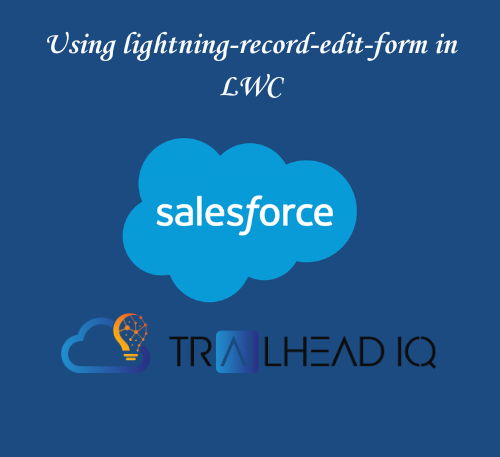The lightning-record-edit-form component in Lightning Web Components (LWC) allows you to create a form for adding or updating Salesforce records. In this blog, we’ll explore how to use this component effectively, including detailed examples and explanations.
Purpose of lightning-record-edit-form
- Record Interaction: Create a form that interacts with Salesforce records.
- Field Display: Display fields with their labels and current values, allowing users to edit those values.
- Client-side Validations: Implement client-side JavaScript validations for specific use cases.
- Salesforce Validations: Create Salesforce validations to prevent records from being saved if they don’t meet certain criteria.
Use Cases
- Edit Existing Records: Edit specified fields of an existing record (given the record ID).
- Create New Records: Create a new record using specified fields.
Example: Creating a Contact Form
Suppose we want to create a form for adding contact records. We’ll specify the object-api-name attribute as Contact to indicate that we’re working with contact records. Inside the form, we’ll include lightning-input-field components to represent the fields we want to edit or create.
HTML (contactForm.html)
<template>
<lightning-card title="New Contact Form">
<div class="slds-p-around_medium">
<lightning-record-edit-form
object-api-name="Contact"
onsuccess={handleSuccess}
onerror={handleError}>
<lightning-messages></lightning-messages>
<lightning-input-field field-name="FirstName"></lightning-input-field>
<lightning-input-field field-name="LastName"></lightning-input-field>
<lightning-input-field field-name="Email"></lightning-input-field>
<div class="slds-m-top_medium">
<lightning-button variant="brand" type="submit" label="Save"></lightning-button>
</div>
</lightning-record-edit-form>
</div>
</lightning-card>
</template>
JavaScript (contactForm.js)
import { LightningElement } from 'lwc';
export default class ContactForm extends LightningElement {
handleSuccess(event) {
const newRecordId = event.detail.id;
console.log('New Contact created with Id: ' + newRecordId);
// You can display a success message, clear the form, or navigate to the newly created record
}
handleError(event) {
console.error('Error creating new Contact: ' + event.detail.message);
// Handle the error event when there is an error saving the record
}
}Detailed Explanation
- Template Structure:
- The HTML template includes a
lightning-cardcomponent that contains alightning-record-edit-form. - The
object-api-nameattribute specifies the Salesforce object (in this case,Contact). lightning-messagesdisplays any validation or error messages.lightning-input-fieldcomponents represent the fields to be edited or created.- A
lightning-buttonis used to submit the form.
- The HTML template includes a
- JavaScript Logic:
- The
handleSuccessmethod is triggered when the record is successfully saved. It logs the new record ID and can be used to display a success message, clear the form, or navigate to the new record. - The
handleErrormethod is triggered if there’s an error saving the record. It logs the error message.
- The
Additional Examples
Example 2: Editing an Existing Record
To edit an existing record, set the record-id attribute in the lightning-record-edit-form component.
<template>
<lightning-card title="Edit Contact">
<div class="slds-p-around_medium">
<lightning-record-edit-form
object-api-name="Contact"
record-id={recordId}
onsuccess={handleSuccess}
onerror={handleError}>
<lightning-messages></lightning-messages>
<lightning-input-field field-name="FirstName"></lightning-input-field>
<lightning-input-field field-name="LastName"></lightning-input-field>
<lightning-input-field field-name="Email"></lightning-input-field>
<div class="slds-m-top_medium">
<lightning-button variant="brand" type="submit" label="Save"></lightning-button>
</div>
</lightning-record-edit-form>
</div>
</lightning-card>
</template>
import { LightningElement, api } from 'lwc';
export default class EditContactForm extends LightningElement {
@api recordId; // The ID of the record to be edited
handleSuccess(event) {
console.log('Contact updated successfully');
}
handleError(event) {
console.error('Error updating Contact: ' + event.detail.message);
}
}Implementing Client-Side Validations
You can implement client-side validations using standard JavaScript. For example, you might want to ensure that the email address is in a valid format before allowing the form to be submitted.
JavaScript (contactForm.js)
import { LightningElement } from 'lwc';
export default class ContactForm extends LightningElement {
handleSuccess(event) {
const newRecordId = event.detail.id;
console.log('New Contact created with Id: ' + newRecordId);
}
handleError(event) {
console.error('Error creating new Contact: ' + event.detail.message);
}
handleSubmit(event) {
event.preventDefault(); // Prevent the default form submission
const fields = event.detail.fields;
// Custom client-side validation
if (!this.isValidEmail(fields.Email)) {
// Display an error message or take appropriate action
console.error('Invalid email address');
return;
}
this.template.querySelector('lightning-record-edit-form').submit(fields);
}
isValidEmail(email) {
const emailRegex = /^[^\s@]+@[^\s@]+\.[^\s@]+$/;
return emailRegex.test(email);
}
}
HTML (contactForm.html)
<template>
<lightning-card title="New Contact Form">
<div class="slds-p-around_medium">
<lightning-record-edit-form
object-api-name="Contact"
onsuccess={handleSuccess}
onerror={handleError}
onsubmit={handleSubmit}>
<lightning-messages></lightning-messages>
<lightning-input-field field-name="FirstName"></lightning-input-field>
<lightning-input-field field-name="LastName"></lightning-input-field>
<lightning-input-field field-name="Email"></lightning-input-field>
<div class="slds-m-top_medium">
<lightning-button variant="brand" type="submit" label="Save"></lightning-button>
</div>
</lightning-record-edit-form>
</div>
</lightning-card>
</template>
Conclusion
Using lightning-record-edit-form in LWC is a powerful way to create and update Salesforce records with minimal code. By understanding the structure and capabilities of this component, you can build efficient and user-friendly forms for your Salesforce applications. Implementing client-side validations further enhances the user experience by providing immediate feedback and ensuring data integrity.







